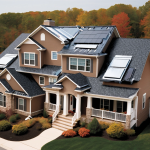Comprehensive Guide to DIY Storm Window Installation: Maximize Energy Efficiency and Weather Protection
Introduction: Weatherizing Your Home with DIY Storm Windows
As energy costs continue to rise and extreme weather events become more frequent, homeowners are seeking affordable and effective ways to improve home insulation and protect their properties. Storm windows offer a practical solution, providing an extra layer of defense against drafts, heat loss, and weather damage. While professional installation is an option, DIY storm window installation presents a cost-effective alternative for homeowners willing to invest a little time and effort. This comprehensive guide will walk you through every step of the process, from choosing the right type of storm window to maintaining its long-term performance.
The escalating demand for energy-efficient windows is intrinsically linked to the growing awareness of climate change and the economic burden of inefficient home weatherization. Beyond merely reducing monthly utility bills, strategically implemented storm window installation contributes significantly to a home’s overall thermal performance. Modern energy-efficient windows, often incorporating advanced glass technologies like low-emissivity (Low-E) coatings and argon gas fills, minimize heat transfer. However, even older windows can benefit substantially from the addition of storm windows, effectively creating a double-pane system that dramatically reduces heat loss during winter and heat gain during summer, thereby lessening the strain on HVAC systems and prolonging their lifespan.
DIY storm windows represent a tangible step towards bolstering home resilience against increasingly volatile weather patterns. The benefits extend beyond simple cost savings; they encompass enhanced comfort, reduced noise pollution, and the preservation of original windows. Investing in DIY storm windows aligns with a proactive approach to homeownership, empowering individuals to take control of their living environment and mitigate the impact of external elements. Furthermore, the selection of appropriate materials, from durable acrylic to tempered glass, allows for customization based on specific regional weather conditions and aesthetic preferences, ensuring both functionality and visual appeal.
Thoughtful storm window installation is therefore an investment in both immediate comfort and long-term property value. Moreover, the environmental implications of improved window insulation are noteworthy. By reducing energy consumption for heating and cooling, homeowners actively contribute to lowering their carbon footprint. The cumulative effect of widespread adoption of energy-efficient windows and effective home weatherization practices can significantly reduce reliance on fossil fuels and promote a more sustainable energy future. Government incentives and rebates often further incentivize these upgrades, making storm window installation an even more compelling proposition. This guide aims to equip homeowners with the knowledge and skills necessary to make informed decisions and execute successful DIY storm window projects, ultimately fostering a more energy-conscious and resilient community.
Choosing the Right Storm Window: Types and Materials
Before embarking on your DIY storm window project, it’s crucial to understand the different types of storm windows available, as the choice significantly impacts both weather protection and energy efficiency. The most common types include single-pane, double-pane, and low-E storm windows, each offering a distinct balance of cost, performance, and ease of storm window installation. Understanding these differences is paramount for effective home weatherization. This initial decision sets the stage for the entire project, influencing long-term energy savings and the overall comfort of your home.
Making an informed choice here will ensure that your DIY storm windows project aligns with your specific needs and budget. Single-pane storm windows are the most basic and affordable option, consisting of a single pane of glass or acrylic within a frame. While they represent the entry-level solution for window insulation, they still offer a noticeable improvement compared to bare windows, particularly in mitigating drafts and reducing heat loss. These are an excellent choice for homeowners on a tight budget who are looking for a simple way to enhance their home weatherization efforts.
Keep in mind that while they provide a barrier against the elements, their energy efficiency is considerably lower than that of double-pane or low-E options. They are a good starting point for those new to DIY storm windows and looking to gain experience with the installation process. Double-pane storm windows, featuring two panes of glass with an air gap in between, provide superior insulation and noise reduction compared to single-pane options. The air gap acts as a thermal break, further reducing heat transfer and improving energy efficiency.
While more expensive than single-pane models, the increased performance makes them a worthwhile investment for homeowners seeking enhanced home weatherization and lower energy bills. The improved window insulation offered by double-pane storm windows can significantly reduce the strain on your heating and cooling systems, leading to long-term cost savings. This type of storm window represents a solid middle ground between affordability and performance. Low-E storm windows represent the pinnacle of energy-efficient windows technology for storm window applications.
These windows are coated with a thin, transparent layer of metallic oxide that reduces heat transfer, making them highly effective at blocking solar heat gain in the summer and retaining heat in the winter. While they command a higher price point, the long-term energy savings and enhanced comfort they provide make them an attractive option for homeowners prioritizing energy efficiency. Low-E coatings selectively filter the solar spectrum, allowing visible light to pass through while reflecting infrared and ultraviolet radiation.
This technology not only improves window insulation but also helps protect interior furnishings from fading. Investing in low-E storm windows is a strategic decision for maximizing the benefits of home weatherization. Beyond the pane configuration, the frame material also plays a crucial role in the overall performance and longevity of your storm windows. Common frame materials include aluminum, vinyl, and wood, each with its own set of advantages and disadvantages. Aluminum frames are durable and low-maintenance but can be prone to condensation in colder climates due to their high thermal conductivity.
Vinyl frames offer excellent insulation and are resistant to rot and decay, making them a popular choice for energy-efficient windows. Wood frames provide a classic aesthetic and can be easily painted or stained to match your home’s décor, but they require regular maintenance to prevent moisture damage. Consider the climate in your region and your aesthetic preferences when selecting the frame material for your DIY storm windows. Consider your budget, climate, and desired level of energy efficiency when selecting the right type of storm window for your home.
For homeowners in regions with extreme temperature fluctuations, investing in double-pane or low-E storm windows is a wise choice for maximizing energy savings and improving comfort. If budget is a primary concern, single-pane storm windows offer a cost-effective way to improve window insulation and reduce drafts. Regardless of the type you choose, proper storm window installation is essential for achieving optimal performance and ensuring long-term durability. Remember to carefully measure your windows and follow the manufacturer’s instructions for installation to avoid any issues. Taking the time to research and select the right storm windows will pay off in the form of lower energy bills, increased comfort, and a more weather-resistant home.
Measuring for Success: Accurate Sizing Techniques
Accurate measurements are essential for a successful storm window installation. Follow these steps to ensure a precise fit: Measure the Window Opening: Use a measuring tape to determine the width and height of the window opening where the storm window will be installed. Measure from the inside edges of the window frame. Account for Tolerances: Subtract approximately 1/8 inch from both the width and height measurements to allow for slight variations and ensure a comfortable fit.
This tolerance prevents the storm window from being too tight and potentially causing damage to the existing window frame. Order or Cut to Size: If purchasing pre-made storm windows, order the size that is closest to your measurements, erring on the smaller side if necessary. If building your own storm windows, cut the materials to the precise dimensions, taking into account the frame thickness. When embarking on your DIY storm windows project, remember that precision is paramount not just for fit, but also for maximizing the energy-efficient windows’ potential.
A poorly fitted storm window can negate many of the benefits of home weatherization, leading to drafts and reduced window insulation. Double-check each measurement, and consider using a laser measuring tool for increased accuracy, especially for larger or unusually shaped windows. This small investment in accuracy can save significant money on energy bills in the long run. Remember that even slight gaps can compromise the thermal barrier, allowing heat to escape in the winter and enter in the summer.
Beyond simple width and height, assess the squareness of your window opening. Older homes, in particular, may have frames that are no longer perfectly square due to settling. Measure the diagonals of the opening; if they are not equal, you’ll need to account for this discrepancy when ordering or building your storm windows. Consider using flexible or adjustable storm windows for non-square openings, or consult with a professional for solutions tailored to your specific situation.
Addressing these irregularities ensures a tight seal and prevents air leakage, a key factor in effective storm window installation and overall home weatherization. Finally, think about the mounting hardware you’ll be using and how it will impact the final dimensions. Interior storm windows, for example, often require a slightly different measuring approach than exterior ones. Consider the thickness of the mounting strips or clips and factor that into your calculations. Before finalizing your order or cutting materials, create a simple template or mock-up to test the fit. This extra step can prevent costly mistakes and ensure that your storm window installation provides optimal protection against extreme weather and contributes significantly to energy savings. Proper window insulation starts with meticulous measurement and planning.
Step-by-Step Installation: A Visual Guide
With the right tools and materials prepared, you can confidently proceed with your DIY storm window installation. Before you begin, double-check that the storm windows you’ve selected are indeed the correct size for each window opening. Minor discrepancies can lead to significant air leaks, negating the energy-efficient windows benefits you’re aiming for. Gather Your Supplies: At a minimum, you’ll need the storm windows themselves, a reliable measuring tape, a drill with a selection of drill bits (including a countersinking bit), appropriately sized screws (stainless steel or coated for weather resistance are recommended), exterior-grade caulk, safety glasses, work gloves, a level, and potentially shims for fine-tuning the fit.
Prepare the Window Frame: Thorough preparation is key to successful home weatherization. Clean the existing window frame meticulously to remove all traces of dirt, debris, old caulk, and any loose paint. A scraper and wire brush can be helpful here. For optimal adhesion of the new caulk, consider applying a primer specifically designed for exterior surfaces. This ensures a robust seal, preventing moisture infiltration and drafts, which are primary culprits in energy loss. According to the U.S.
Department of Energy, air leaks can account for as much as 30% of a home’s heating and cooling energy loss, underscoring the importance of this step. Position the Storm Window: Carefully lift and position the storm window within the window opening. Ensure it is centered both horizontally and vertically, and use a level to verify that it sits perfectly plumb. If the window frame is slightly out of square (common in older homes), use shims to achieve a level and even fit.
An improperly aligned storm window not only looks unsightly but also compromises its ability to create an airtight seal. For larger windows, consider having a helper assist with positioning to prevent accidental drops or damage. Secure the Storm Window: Once you’re satisfied with the positioning, use a drill to pre-drill pilot holes through the storm window frame and into the existing window frame. Pre-drilling prevents the wood from splitting and ensures that the screws will hold securely.
Use a countersinking bit to create a beveled edge around each pilot hole, allowing the screw heads to sit flush with the storm window frame. This creates a cleaner, more professional look and prevents the screw heads from interfering with the caulk. Then, insert screws to securely fasten the storm window in place. Avoid over-tightening the screws, as this can warp the frame. Caulk the Edges: Apply a continuous and uniform bead of exterior-grade caulk around the entire perimeter of the storm window where it meets the existing window frame.
Use a caulk gun to apply the caulk, and then smooth it with a wet finger or a caulking tool for a professional finish. Pay particular attention to corners and seams, ensuring that there are no gaps or voids. The goal is to create an airtight and watertight seal that will prevent drafts, leaks, and moisture damage. This final step is crucial for maximizing the energy efficiency gains from your storm window installation and protecting your home from extreme weather. Properly installed storm windows can reduce energy bills by 10-20%, making them a worthwhile investment in home weatherization.
DIY vs. Professional Installation: Costs and Benefits
Deciding between DIY storm window installation and professional services involves carefully weighing cost against convenience and expertise. DIY storm windows offer a compelling path to savings, particularly for homeowners comfortable with basic hand tools and home weatherization projects. The financial benefits extend beyond the initial purchase price, as proper storm window installation directly contributes to lower energy bills. However, this route demands a commitment of time and effort, requiring meticulous measurement and careful installation to ensure a weathertight seal.
Errors in installation can negate the energy-saving benefits and potentially lead to water damage or drafts, highlighting the importance of precision and patience. Furthermore, certain window types, such as oversized or unusually shaped windows, may present challenges that exceed the capabilities of the average DIY enthusiast. Professional storm window installation provides assurance of quality and expertise, particularly valuable for complex installations or homeowners prioritizing convenience. Experienced installers possess the knowledge and tools to handle a wide range of window types, ensuring proper fit and optimal performance.
While the upfront cost is higher, the long-term benefits of energy-efficient windows and reduced maintenance may justify the investment. Moreover, professional installation often comes with warranties, providing peace of mind and protection against potential defects or installation errors. Consider, too, that professional installation frees up your time for other home improvement projects or personal pursuits, a factor that should be weighed in the overall decision-making process. Ultimately, the optimal choice hinges on a homeowner’s individual circumstances, balancing budget constraints, DIY skills, and time availability.
For those seeking maximum cost savings and enjoying hands-on projects, DIY storm windows offer a rewarding experience. Conversely, homeowners prioritizing convenience, guaranteed quality, and expertise may find professional storm window installation to be the more suitable option. Regardless of the chosen path, investing in storm windows is a proactive step towards enhancing home weatherization, improving energy efficiency, and safeguarding against the elements. Remember to thoroughly research different storm window options and installer qualifications to make an informed decision that aligns with your specific needs and goals. For example, investing in high-quality, low-E storm windows professionally installed might yield greater long-term energy savings than a budget DIY approach.


